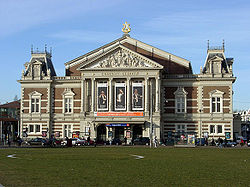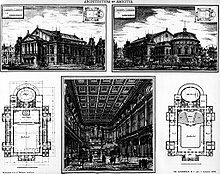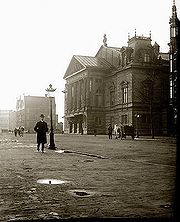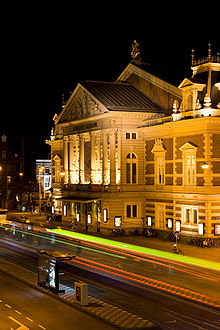- Concertgebouw
-
The Concertgebouw (Dutch pronunciation: [kɔnˈsɛrt.xəˌbʌu]) is a concert hall in Amsterdam, Netherlands. The Dutch term "concertgebouw" literally translates into English as "concert building". Because of its highly regarded acoustics, the Concertgebouw is considered one of the finest concert halls in the world, along with places such as Buenos Aires' Teatro Colón, Boston's Symphony Hall[1][2] and the Musikverein in Vienna.[3]
Contents
History
The architect of the building was Adolf Leonard van Gendt, who was inspired by the Neue Gewandhaus in Leipzig, built two years earlier (and destroyed in 1943).
Construction began in 1883 in a pasture that was then outside the city, in Nieuwer-Amstel, a municipality that in 1964 became Amstelveen. 2,186 piles twelve to thirteen meters (forty to forty-three feet) in length were sunk into the soil.[4]
The hall opened on April 11, 1888, with an inaugural concert in which an orchestra of 120 musicians and a chorus of 500 singers participated, performing works of Wagner, Handel, Bach, and Beethoven. The resident orchestra of the Concertgebouw is the Royal Concertgebouw Orchestra (Koninklijk Concertgebouworkest), which gave its first concert in the hall on 3 November 1888, as the Concertgebouw Orchestra (Concertgebouworkest).
The Grote Zaal ("Great Hall", which is the main hall) seats 2037, and is 44 meters (144 ft) long, 28 meters (92 ft) wide, and 17 meters (56 ft) high. Its reverberation time is 2.8 seconds without audience, 2.2 seconds with, making it ideal for the late Romantic repertoire such as Mahler. Though this characteristic makes it largely unsuited for amplified music, groups such as Led Zeppelin, The Who & Pink Floyd performed there in the 1960s. Furthermore, Paul McCartney mentions it in his song "Rock Show". In addition to orchestras, jazz and world music groups perform in the Grote Zaal. Concert performances of opera also take place there.
A smaller, oval-shaped venue, the Kleine Zaal ("Small Hall"), is located behind the main hall. The Kleine Zaal is 20 meters (66 ft) long and 15 meters (50 ft) wide. Its more intimate space is well-suited for chamber music and lieder. The Kleine Zaal has 478 seats.
When the Concertgebouw was built, acoustics were something of a black art. As in shipbuilding, designers drew upon what had worked in the past without entirely understanding the underlying science (which even today is still not well understood). When the building was completed, the acoustics were not perfect, and a lot of effort went into fine-tuning the aural ambience. During later restorations, particular care has been taken not to alter the materials used for interior decoration with this in mind. In the 1980s, the hall embarked on extensive fund-raising for renovations after the hall was found to be slowly sinking into the ground. Pi de Bruijn was the architect for the contemporary annex to the original hall.[5]
Today, some nine hundred concerts per year take place in the Concertgebouw, for a public of over 800,000, making it the second most-visited concert hall in the world (Rome's Parco della musica ranking N. 1 with over one million).[citation needed]
The current managing director of the Concertgebouw is Simon Reinink. The hall's current artistic director is Anneke Hogenstijn.
Names of composers in the Grote Zaal
In the Grote Zaal, the family names of a number of classical music composers are displayed on the balcony ledges and on the walls. These composers include the following:
- Jacob Obrecht
- Jan Pieterszoon Sweelinck
- Orlando di Lasso
- Jacobus Clemens non Papa
- Pyotr Ilyich Tchaikovsky
- Igor Stravinsky
- Johan Wagenaar
- Max Reger
- Maurice Ravel
- Willem Pijper
- Franz Schubert
- Felix Mendelssohn
See also
- Royal Concertgebouw Orchestra
- History of Amsterdam
- List of concert halls
- Amsterdam Tourist Attractions
References
- ^ April 11, 1888: Concertgebouw, Home of Nearly Perfect Acoustics, Opens
- ^ R.W. Apple, Jr., Apple's America (North Point Press, 2005), ISBN 0-86547-685-3.
- ^ Tapio Lahti and Henrik Möller. "Concert Hall Acoustics and the Computer". ARK -The Finnish Architectural Review. http://www.ark.fi/ark4_96/acoustics.html.
- ^ Drawing of the Concertgebouw in the fields, at the Amsterdam City Archives
- ^ Paul L. Montgomery (1988-04-13). "Dutch Hail Concertgebouw's 100th". New York Times. http://query.nytimes.com/gst/fullpage.html?res=940DE7DB1738F930A25757C0A96E948260&sec=&spon=&pagewanted=all. Retrieved 2007-10-12.
External links
- Concertgebouw website
- Archive of the Concertgebouw at the Amsterdam City Archives
Coordinates: 52°21′22″N 4°52′46″E / 52.356223°N 4.879517°E
Categories:- Concert halls in the Netherlands
- Culture in Amsterdam
- Buildings and structures in Amsterdam
- Buildings and structures completed in 1888
- Royal Concertgebouw Orchestra
Wikimedia Foundation. 2010.






